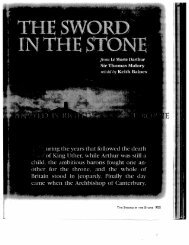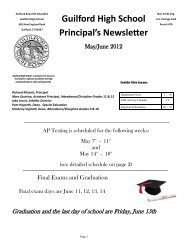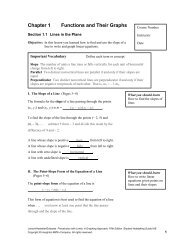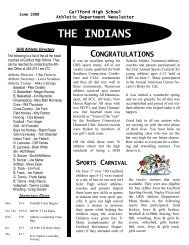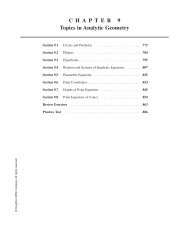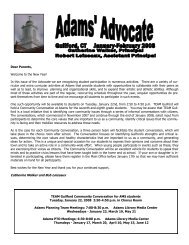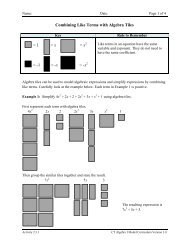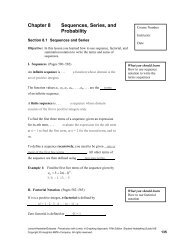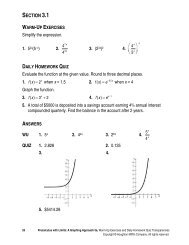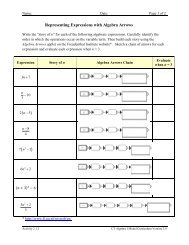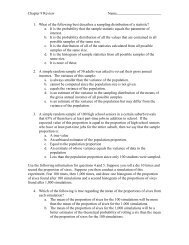10-4 Surface Area of Prisms and Cylinders
10-4 Surface Area of Prisms and Cylinders
10-4 Surface Area of Prisms and Cylinders
You also want an ePaper? Increase the reach of your titles
YUMPU automatically turns print PDFs into web optimized ePapers that Google loves.
<strong>10</strong>-4 <strong>Surface</strong> <strong>Area</strong> <strong>of</strong> <strong>Prisms</strong> <strong>and</strong> <strong>Cylinders</strong><br />
<strong>10</strong>-4<br />
<strong>Surface</strong> <strong>Area</strong> <strong>of</strong><br />
<strong>Prisms</strong> <strong>and</strong> <strong>Cylinders</strong><br />
Warm Up<br />
Lesson Presentation<br />
Lesson Quiz<br />
Holt McDougal Geometry<br />
Geometry
<strong>10</strong>-4 <strong>Surface</strong> <strong>Area</strong> <strong>of</strong> <strong>Prisms</strong> <strong>and</strong> <strong>Cylinders</strong><br />
Objectives<br />
Learn <strong>and</strong> apply the formula for the<br />
surface area <strong>of</strong> a cylinder.<br />
Holt McDougal Geometry
<strong>10</strong>-4 <strong>Surface</strong> <strong>Area</strong> <strong>of</strong> <strong>Prisms</strong> <strong>and</strong> <strong>Cylinders</strong><br />
axis <strong>of</strong> a cylinder<br />
right cylinder<br />
oblique cylinder<br />
Vocabulary<br />
Holt McDougal Geometry
<strong>10</strong>-4 <strong>Surface</strong> <strong>Area</strong> <strong>of</strong> <strong>Prisms</strong> <strong>and</strong> <strong>Cylinders</strong><br />
The lateral surface <strong>of</strong> a cylinder is the curved surface<br />
that connects the two bases. The axis <strong>of</strong> a cylinder is<br />
the segment with endpoints at the centers <strong>of</strong> the<br />
bases. The axis <strong>of</strong> a right cylinder is perpendicular to<br />
its bases. The axis <strong>of</strong> an oblique cylinder is not<br />
perpendicular to its bases. The altitude <strong>of</strong> a right<br />
cylinder is the same length as the axis.<br />
Holt McDougal Geometry
<strong>10</strong>-4 <strong>Surface</strong> <strong>Area</strong> <strong>of</strong> <strong>Prisms</strong> <strong>and</strong> <strong>Cylinders</strong><br />
Holt McDougal Geometry
<strong>10</strong>-4 <strong>Surface</strong> <strong>Area</strong> <strong>of</strong> <strong>Prisms</strong> <strong>and</strong> <strong>Cylinders</strong><br />
Example 2A: Finding Lateral <strong>Area</strong>s <strong>and</strong> <strong>Surface</strong> <strong>Area</strong>s<br />
<strong>of</strong> Right <strong>Cylinders</strong><br />
Find the lateral area <strong>and</strong> surface area <strong>of</strong> the<br />
right cylinder. Give your answers in terms <strong>of</strong> .<br />
Holt McDougal Geometry
<strong>10</strong>-4 <strong>Surface</strong> <strong>Area</strong> <strong>of</strong> <strong>Prisms</strong> <strong>and</strong> <strong>Cylinders</strong><br />
Example 2B: Finding Lateral <strong>Area</strong>s <strong>and</strong> <strong>Surface</strong> <strong>Area</strong>s<br />
<strong>of</strong> Right <strong>Cylinders</strong><br />
Find the lateral area <strong>and</strong> surface area <strong>of</strong> a right<br />
cylinder with circumference 24 cm <strong>and</strong> a height<br />
equal to half the radius. Give your answers in<br />
terms <strong>of</strong> .<br />
Holt McDougal Geometry
<strong>10</strong>-4 <strong>Surface</strong> <strong>Area</strong> <strong>of</strong> <strong>Prisms</strong> <strong>and</strong> <strong>Cylinders</strong><br />
Check It Out! Example 2<br />
Find the lateral area <strong>and</strong> surface area <strong>of</strong> a<br />
cylinder with a base area <strong>of</strong> 49 <strong>and</strong> a height<br />
that is 2 times the radius.<br />
Holt McDougal Geometry
<strong>10</strong>-4 <strong>Surface</strong> <strong>Area</strong> <strong>of</strong> <strong>Prisms</strong> <strong>and</strong> <strong>Cylinders</strong><br />
Check It Out! Example 3<br />
Find the surface area <strong>of</strong> the composite figure.<br />
Round to the nearest tenth.<br />
Holt McDougal Geometry
<strong>10</strong>-4 <strong>Surface</strong> <strong>Area</strong> <strong>of</strong> <strong>Prisms</strong> <strong>and</strong> <strong>Cylinders</strong><br />
Example 4: Exploring Effects <strong>of</strong> Changing<br />
Dimensions<br />
The edge length <strong>of</strong> the cube is tripled. Describe<br />
the effect on the surface area.<br />
Holt McDougal Geometry
<strong>10</strong>-4 <strong>Surface</strong> <strong>Area</strong> <strong>of</strong> <strong>Prisms</strong> <strong>and</strong> <strong>Cylinders</strong><br />
Example 4 Continued<br />
24 cm<br />
Holt McDougal Geometry
<strong>10</strong>-4 <strong>Surface</strong> <strong>Area</strong> <strong>of</strong> <strong>Prisms</strong> <strong>and</strong> <strong>Cylinders</strong><br />
Check It Out! Example 4<br />
The height <strong>and</strong> diameter <strong>of</strong> the cylinder are<br />
multiplied by<br />
. Describe the effect on the<br />
surface area.<br />
Holt McDougal Geometry
<strong>10</strong>-4 <strong>Surface</strong> <strong>Area</strong> <strong>of</strong> <strong>Prisms</strong> <strong>and</strong> <strong>Cylinders</strong><br />
Check It Out! Example 4 Continued<br />
11 cm<br />
7 cm<br />
original dimensions:<br />
height <strong>and</strong> diameter halved:<br />
Holt McDougal Geometry



